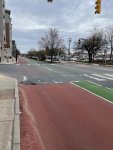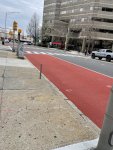My picks that would most benefit Everett IMHO:
SL6 from Glendale Square to Haymarket with local service along the Broadway stretch from Glendale to Alford Street bridge and express service from Alford to Haymarket along Rutherford/Washington Sts (no stopping at Sullivan, Community College, North Station, or any other intermediate points). Fastest service to downtown Boston and GL/OL connections to Back Bay CBD at Haymarket. If the proposed North Station to Seaport BRT happens, then connection to Seaport CBD as well.
SL3 to from existing Chelsea terminus to Sullivan via Everett Square / Broadway. SL6 / SL3 / local bus transfer hub created at Everett Square. Plenty of local bus connections to points west at Sullivan and Airport / Seaport CBD east along existing SL3 service. Could consider extending SL3 for one stop ride to Kendall with cross connection at GLX East Somerville station; however street routing is a little wonky and indirect (hence the need for Sullivan to GJ light rail connect, but that’s for a different thread). Probably just rework the local bus routing to better serve Kendall from Sullivan.
The point should be really to keep it simple. Often times these initiatives get bogged down or don’t meet expectations because they try to do too much or forget the project objective, which in this case is to improve access for Everett riders.
Yes, this is basically my view as well. If I have to pick one of these two, I go with the SL6 option (but I think both have merit). And yes -- as few stops as possible after the bridge, assuming that SL6 is implemented without removing buses from the 104/109 (i.e. riders heading for Sullivan still maintain as much access as today). The only exception I would toss out there would be a stop at Bunker Hill Community College -- not the train station, just near the intersection with Austin St. That seems like it could be a potential destination unto itself, so worth considering. But I don't think other stops along Rutherford are necessary, and my gut says that a diversion to Sullivan is not worth it.
I wrote this previously about Rutherford: It directly parallels the OL and the 92, and there's not any useful local stops to add that the OL doesn't serve other than City Square. The only way I can really see it making sense is with a dedicated busway on Rutherford, a lot of infill development on Rutherford to justify a stop at Essex Street, and use of a Congress Street BRT to get to South Station.
However, I do like the idea of that Everett-Sullivan-Lechmere-Kendall corridor. Given how many different nodes that connects, I don't think mixing the radial and circumferential elements would be a big issue
To be clear, my support for the Rutherford route is contingent on it being a speedy route -- I assume that would require bus lanes, but perhaps traffic moves quickly enough that they are unnecessary (I am skeptical, but). And I think the offering is significantly stronger with a BRT extension to South Station, although I think a Haymarket terminus would be perfectly reasonable in the short-term.
Running via Rutherford is not about serving Charlestown -- as you say, already served by the 92. It's about providing Everett a direct connection to downtown -- Everett being one of three municipalities directly bordering Boston that does not have such a connection (once GLX finishes), and by far the closest and probably the most transit-oriented of the three. (The other two are Winthrop and Milton, the latter possibly being debatable.) Rutherford just happens to be the best (only) road connection between Everett and Downtown, but conceptually it's no different than the Haymarket North extension running through/by Charlestown without really serving it, or a hypothetical Green Line branch to Chelsea doing the same.
As for Sullivan-Lechmere-Kendall: I think that needs to be a separate service. As of now, there are no plans for bus lanes in Cambridge between Kendall and Lechmere (as far as I know), so reliability will be significantly reduced. I think that calls for a shorter service. Also, as mentioned above, a Sullivan-Lechmere bus route could tag along with an Everett-Haymarket route by leveraging bus lanes on Rutherford to the Gilmore Bridge (which I believe is a slightly shorter route than going via McGrath).




